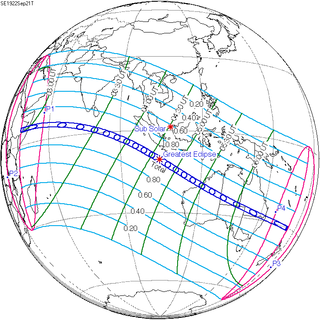| Solar eclipse of September 21, 1922 | |
|---|---|
| Type of eclipse | |
| Nature | Total |
| Gamma | −0.213 |
| Magnitude | 1.0678 |
| Maximum eclipse | |
| Duration | 359 s (5 min 59 s) |
| Coordinates | 10°42′S 104°30′E / 10.7°S 104.5°E |
| Max. width of band | 226 km (140 mi) |
| Times (UTC) | |
| Greatest eclipse | 4:40:31 |
| References | |
| Saros | 133 (40 of 72) |
| Catalog # (SE5000) | 9333 |
A total solar eclipse occurred at the Moon's ascending node of orbit on Thursday, September 21, 1922,[1] with a magnitude of 1.0678. A solar eclipse occurs when the Moon passes between Earth and the Sun, thereby totally or partly obscuring the image of the Sun for a viewer on Earth. A total solar eclipse occurs when the Moon's apparent diameter is larger than the Sun's, blocking all direct sunlight, turning day into darkness. Totality occurs in a narrow path across Earth's surface, with the partial solar eclipse visible over a surrounding region thousands of kilometres wide. Occurring only about 2 hours after perigee (on September 21, 1922, at 6:30 UTC), the Moon's apparent diameter was larger.[2] Perigee did occur as the eclipse was past its greatest eclipse.
Totality started in Ethiopia, Italian Somaliland (today's Somalia), and passed British Maldives and Christmas Island in the Straits Settlements (now in Australia) in the Indian Ocean, and Australia. A partial eclipse was visible for parts of East Africa, South Asia, Southeast Asia, Australia, and Oceania.
- ^ "September 21, 1922 Total Solar Eclipse". timeanddate. Retrieved 2 August 2024.
- ^ "Moon Distances for London, United Kingdom, England". timeanddate. Retrieved 2 August 2024.
